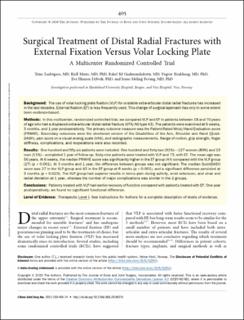Surgical Treatment of Distal Radial Fractures with External Fixation Versus Volar Locking Plate A Multicenter Randomized Controlled Trial
Ludvigsen, Trine; Matre, Kjell; Gudmundsdottir, Rakel Sif; Krukhaug, Yngvar; Dybvik, Eva Hansen; Fevang, Jonas Meling
Journal article, Peer reviewed
Published version

Åpne
Permanent lenke
https://hdl.handle.net/11250/2770012Utgivelsesdato
2021Metadata
Vis full innførselSamlinger
- Department of Clinical Medicine [2066]
- Registrations from Cristin [9791]
Sammendrag
Background:
The use of volar locking plate fixation (VLP) for unstable extra-articular distal radial fractures has increased in the last decades. External fixation (EF) is less frequently used. This change of surgical approach has only to some extent been evidence-based.
Methods:
In this multicenter, randomized controlled trial, we compared VLP and EF in patients between 18 and 70 years of age who had a displaced extra-articular distal radial fracture (OTA/AO type A3). The patients were examined at 6 weeks, 3 months, and 1 year postoperatively. The primary outcome measure was the Patient-Rated Wrist/Hand Evaluation score (PRWHE). Secondary outcomes were the shortened version of the Disabilities of the Arm, Shoulder and Hand (QuickDASH), pain score on a visual analog scale (VAS), and radiographic measurements. Range of motion, grip strength, finger stiffness, complications, and reoperations were also recorded.
Results:
One hundred and fifty-six patients were included. One hundred and forty-two (91%)—127 women (89%) and 15 men (11%)—completed 1 year of follow-up. Sixty-nine patients were treated with VLP and 73, with EF. The mean age was 56 years. At 6 weeks, the median PRWHE score was significantly higher in the EF group (44) compared with the VLP group (27) (p < 0.001). At 3 months and 1 year, the difference between groups was not significant. The median QuickDASH score was 27 in the VLP group and 43 in the EF group at 6 weeks (p < 0.001), and a significant difference persisted at 3 months (p = 0.023). The VLP group had superior results in terms pain during activity, wrist extension, and ulnar and radial deviation at 1 year, whereas the number of major complications was similar in the 2 groups.
Conclusions:
Patients treated with VLP had earlier recovery of function compared with patients treated with EF. One year postoperatively, we found no significant functional difference.
